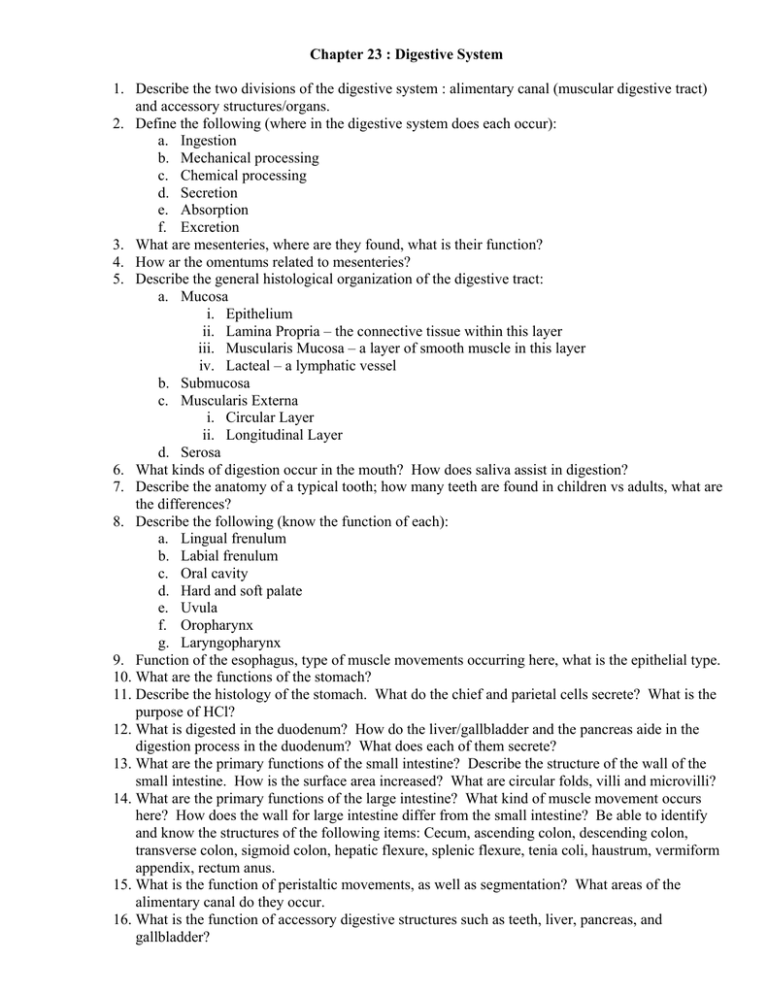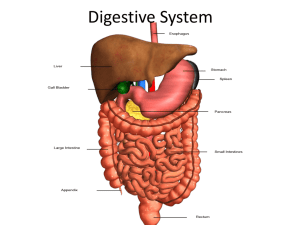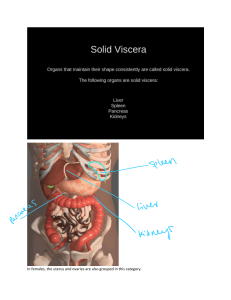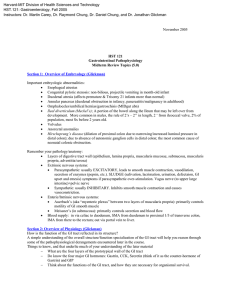Chapter 23 : Digestive System and accessory structures/organs.
advertisement

Chapter 23 : Digestive System 1. Describe the two divisions of the digestive system : alimentary canal (muscular digestive tract) and accessory structures/organs. 2. Define the following (where in the digestive system does each occur): a. Ingestion b. Mechanical processing c. Chemical processing d. Secretion e. Absorption f. Excretion 3. What are mesenteries, where are they found, what is their function? 4. How ar the omentums related to mesenteries? 5. Describe the general histological organization of the digestive tract: a. Mucosa i. Epithelium ii. Lamina Propria – the connective tissue within this layer iii. Muscularis Mucosa – a layer of smooth muscle in this layer iv. Lacteal – a lymphatic vessel b. Submucosa c. Muscularis Externa i. Circular Layer ii. Longitudinal Layer d. Serosa 6. What kinds of digestion occur in the mouth? How does saliva assist in digestion? 7. Describe the anatomy of a typical tooth; how many teeth are found in children vs adults, what are the differences? 8. Describe the following (know the function of each): a. Lingual frenulum b. Labial frenulum c. Oral cavity d. Hard and soft palate e. Uvula f. Oropharynx g. Laryngopharynx 9. Function of the esophagus, type of muscle movements occurring here, what is the epithelial type. 10. What are the functions of the stomach? 11. Describe the histology of the stomach. What do the chief and parietal cells secrete? What is the purpose of HCl? 12. What is digested in the duodenum? How do the liver/gallbladder and the pancreas aide in the digestion process in the duodenum? What does each of them secrete? 13. What are the primary functions of the small intestine? Describe the structure of the wall of the small intestine. How is the surface area increased? What are circular folds, villi and microvilli? 14. What are the primary functions of the large intestine? What kind of muscle movement occurs here? How does the wall for large intestine differ from the small intestine? Be able to identify and know the structures of the following items: Cecum, ascending colon, descending colon, transverse colon, sigmoid colon, hepatic flexure, splenic flexure, tenia coli, haustrum, vermiform appendix, rectum anus. 15. What is the function of peristaltic movements, as well as segmentation? What areas of the alimentary canal do they occur. 16. What is the function of accessory digestive structures such as teeth, liver, pancreas, and gallbladder? 17. What are the four enzymes secreted by the pancreas, what are their functions, and what cells secrete the enzymes. 18. What are the two hormones secreted by the pancreas, and what are their functions (which cells secrete the hormones). 19. What is the function of the pancreatic duct, and how is it associated with the common bile duct? 20. Describe the path of nutrients as they enter the liver (hepatic portal vein) and then into the inferior vena cava (name the vessels in the pathway). 21. What are the names of the ducts that transport bile from the liver and gallbladder into the duodenum?







